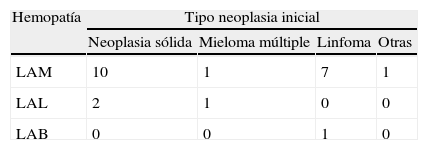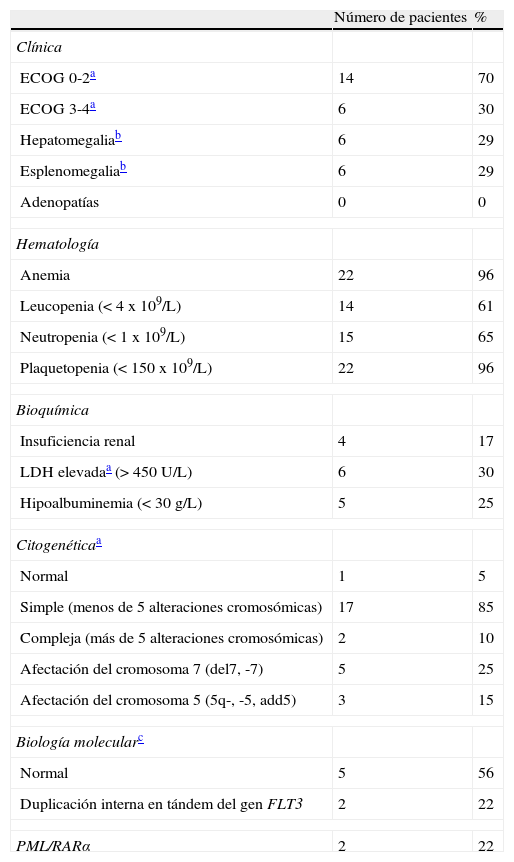El uso creciente de tratamientos antineoplásicos ha provocado un aumento de la incidencia de leucemias agudas secundarias (LAS). El objetivo de este trabajo fue describir las características de las LAS en un solo centro.
Pacientes y métodoSe registraron 23 casos de LAS. Se analizaron los agentes citotóxicos utilizados, tiempo hasta el diagnóstico, características clínico-biológicas, tratamiento y pronóstico.
ResultadosLa edad mediana fue de 61 años. Los agentes administrados en la neoplasia previa fueron: alquilantes (17 pacientes), inhibidores de la DNA topoisomerasa II (14), antitubulina (12), radioterapia (9, en 6 con quimioterapia) y antimetabolitos (6). La mediana de tiempo hasta la aparición de la LAS fue 3 años (extremos 1,2-15,8). Trece pacientes recibieron quimioterapia intensiva (3 se consolidaron con un trasplante de progenitores hematopoyéticos [TPH]) mientras que los 10 restantes recibieron tratamiento de soporte (mediana de supervivencia de 3 años frente a 0,079 años, p=0,004).
ConclusionesEn este estudio, la LAS se asoció con la exposición de agentes alquilantes, inhibidores de la topoisomerasa II y agentes antitubulina. La respuesta al tratamiento y el pronóstico fueron malos, aunque la quimioterapia y el TPH podrían proporcionar una supervivencia más prolongada.
The growing use of antineoplastic treatments has led to an increase in the incidence of therapy-related leukemias (TRL). The objective was to describe the characteristics of TRL.
Patients and methodsTwenty-three cases of TRL were registered. Chemotherapeutic agents used for the first tumor, time interval, clinical and biological characteristics, treatment and prognosis of the TRL were analyzed.
ResultsMedian age was 61 years. Cytotoxic agents used in previous neoplasm consisted of alkylating agents (17 patients), inhibitors of DNA topoisomerase II (14), antitubulin agents (12), radiotherapy (9, in 6 with radiotherapy) and antimetabolites (6). Median time from diagnosis of the first neoplasm to TRL was 3 years (range 1.2-15.8). Thirteen patients received intensive chemotherapy [with stem cell transplantation (SCT) in 3] and the other 10 received symptomatic treatment (median survival 3 years versus 0.079 years, P=0.004).
ConclusionsIn this study, TRL were associated with exposure to alkylating agents, antitubulin agents and topoisomerase II inhibitors. Response to treatment and prognosis were poor, although chemotherapy and SCT may prolong survival.
Artículo
Comprando el artículo el PDF del mismo podrá ser descargado
Precio 19,34 €
Comprar ahora










